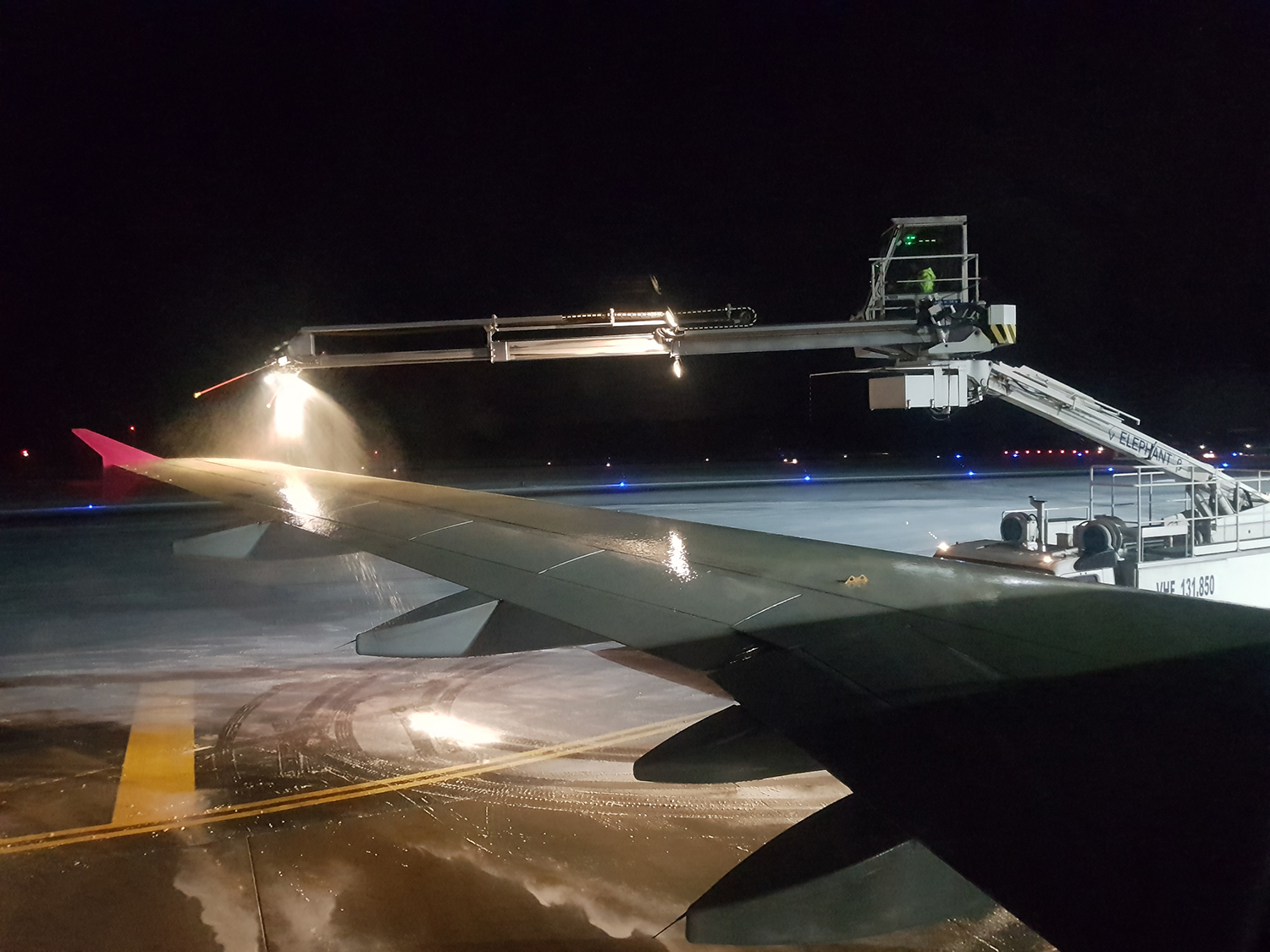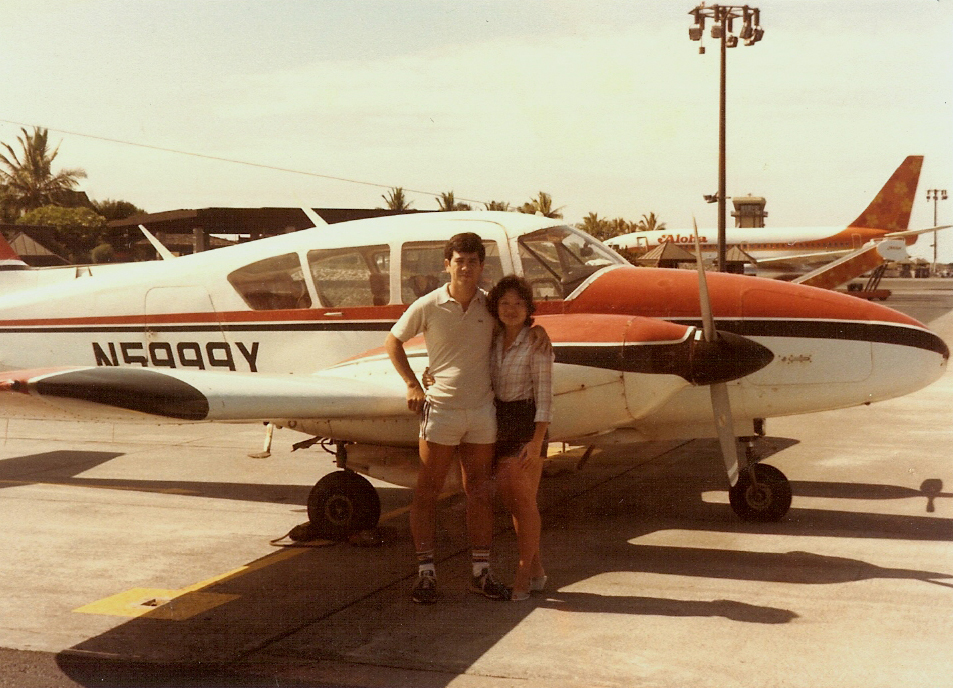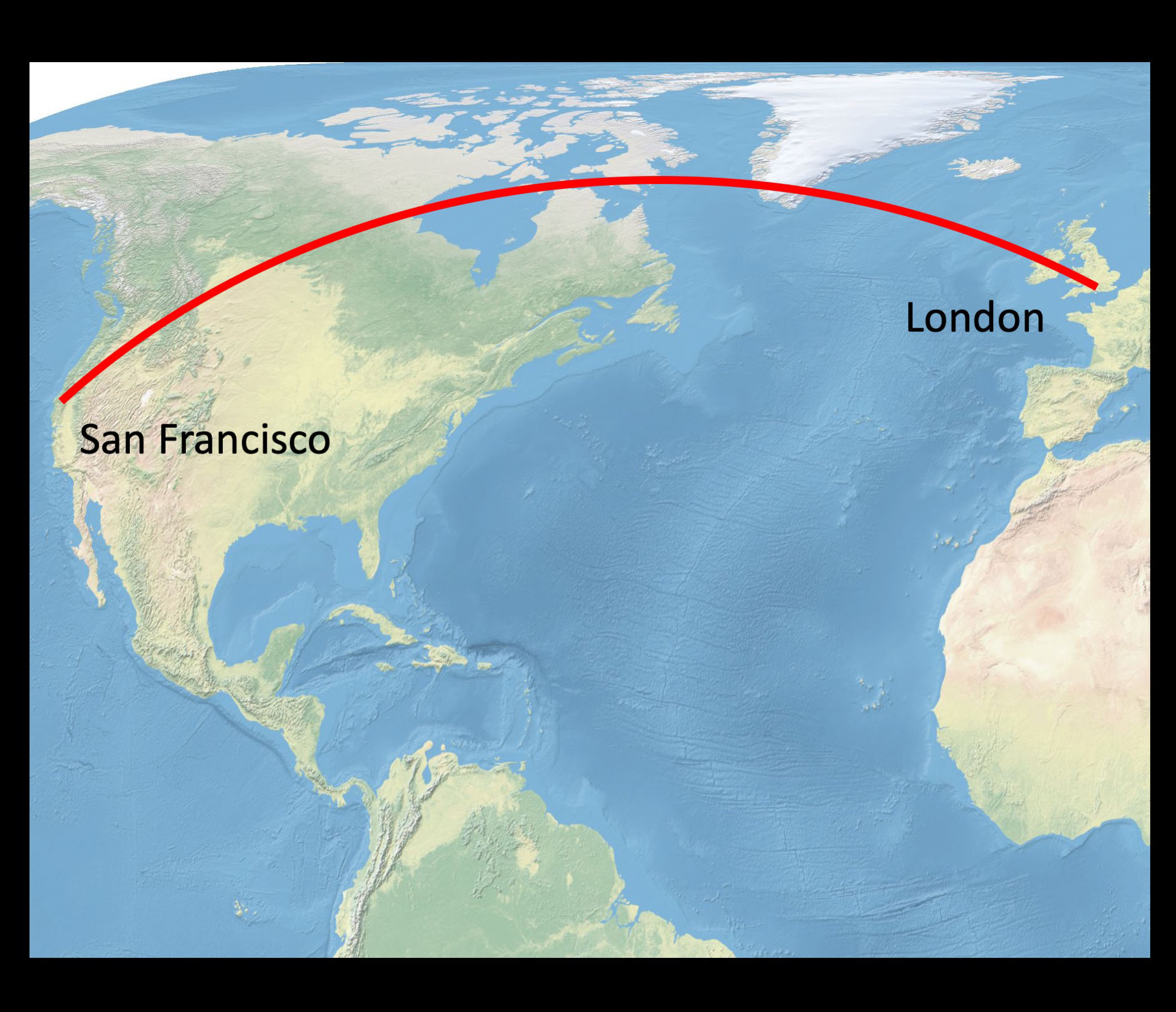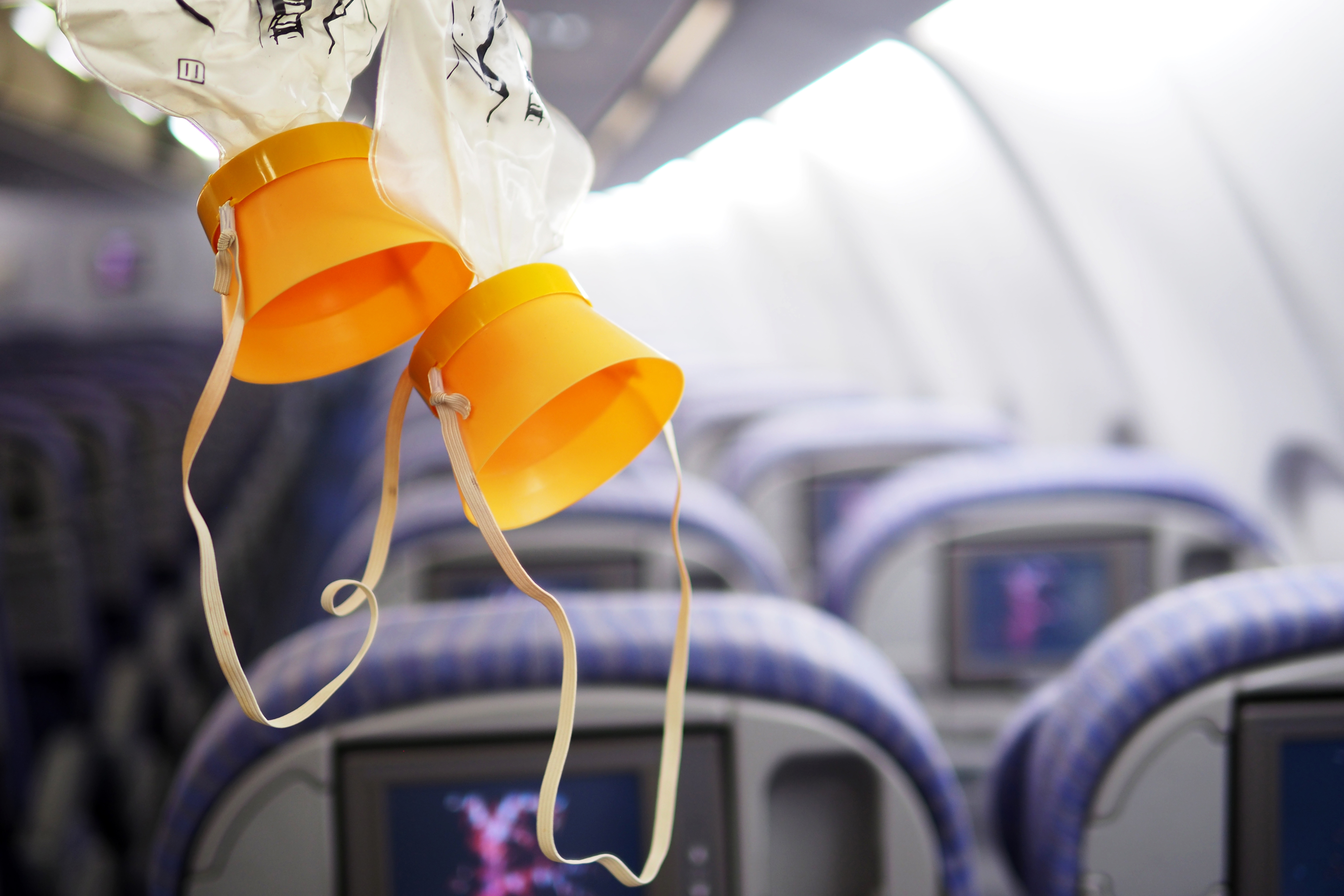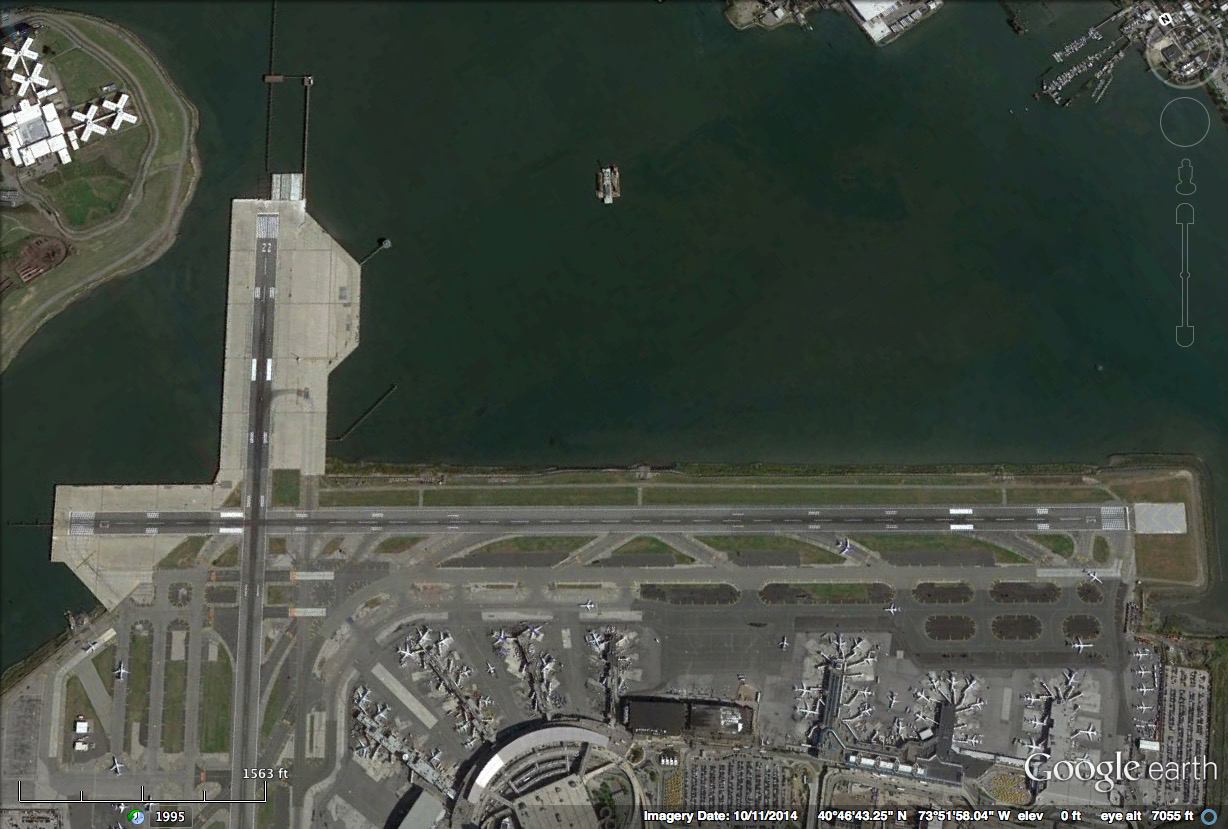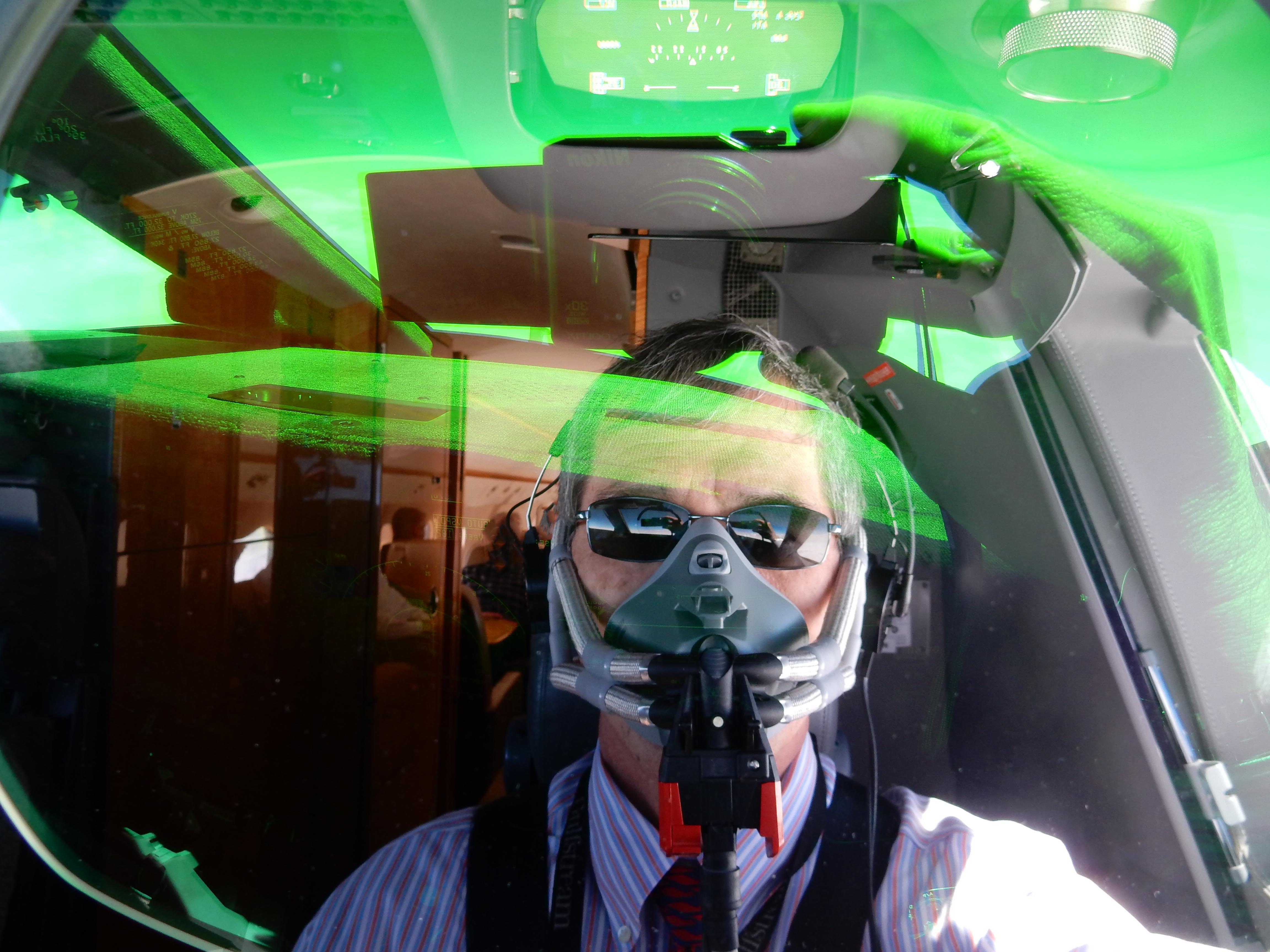The flying public has a lot of misconceptions about aviation in general and how we do our jobs in specific. It is even worse when members of our profession — or just pilots of any kind — have these same misconceptions. Let's look at a few. Much of this is hearsay and that is okay. It may provide a laugh or two or it might enlighten us to be on the lookout for these examples of "fake news."
— James Albright

Updated:
2019-07-21
Our top story tonight . . . airplane deicing
A few years ago, I was sitting in an airline cabin on a snowy, Massachusetts day awaiting our departure from Boston Logan International Airport (KBOS). I was in the aisle seat, on the left side of the airplane, just aft of the wing. To my left there was a young man and to his left a young lady. She was already seated when I arrived, the young man took his seat last. After everyone boarded, the airplane was pushed back and the captain explained we would need to deice. After a few minutes we could hear the spray of the Type 4 above and forward of us and then the wings. The woman, nervously pointing out the window, asked to nobody in particular, "What are they spraying on the wings?"
The young man said, "It's heated salt water."
"Why do they use salt water?" she asked.
"It has a lower freeze point, there is no cause for concern," he explained. "I am a pilot, these are things we have to know."
I held my tongue as the young man waxed eloquently about flying. "That is so amazing," she said. He explained that he was multi-engine rated, that meant he could fly anything with more than one engine. "But isn't it dangerous?" she asked. "It's safer than driving," he said. I decided to tune them both out.
Hypothesis: Flying is Safer Than Driving
Not necessarily true.
Have you ever heard that the most dangerous part of your trip will be the drive to and from the airport? That is probably true if you are a business or commercial aviation pilot. But it isn't true for everyone.
A few years ago, John King tossed a boulder into the quiet pond of general aviation safety and accident prevention by suggesting that the industry does a poor job of teaching pilots to confront an unpleasant truth: Flying light aircraft can be risky and you can kill yourself doing it. Indeed, the industry does itself a disservice by selling itself as an all-purpose transportation system that’s an alternative to the airlines.
Personally, I grow weary of articles in the aviation press touting the benefits of GA over the airlines or driving that completely gloss over the high cost, occasional hassle and, above all, the risk of GA flying.
Despite the fact that the aviation press writes about aircraft accidents ad nauseam, aircraft owners tend to have an unrealistically rosy view of the hazards they face, what the Kings generally call the “big lie.”
Even experienced pilots, argue the Kings, often don’t have a realistic assessment of flight risks and thus they expose themselves and their passengers to more risk than might be acceptable if they truly understood the odds. Inevitably, you have to throw numbers at this to grasp it fully and the Kings do that in this program by debunking the myth that the drive to the airport is the most hazardous part of any flight.
While that’s true if you’re flying the airlines, the overall risk of being in a light aircraft accident is seven times greater than the risk of a car accident and 49 times greater than the chances of being involved in an airline crash.
According to the King’s research, the GA accident risk, on a per-mile basis, is about on par with motorcycles, a reality I suspect most pilots don’t grasp, even the Honda and Beamer owners. Of course, those numbers apply to both industries in a broad-brush way. But it’s well-known that in any risk group, there are segments that have substantially higher risk of accidents and those that have lower risk, by dint of skill, experience, proficiency and, above all, behavior. Practical Risk Management aims to teach pilots to be in that lower risk group, and the Kings argue that it can be done.
Source: Paul Bertoreli, March 30, 2003, AVweb
Hypothesis: The Route is Curved Because of Winds
Not necessarily true.
I've heard this from passengers but even more alarming I heard this from a pilot I was flying with. If you have an "Airshow" or equivalent system on your airplane, you may get this question from a passenger and it pays to know what you area talking about. In the case of the misinformed pilot I was flying with, one of the passengers asked me if what he said was true. That passenger knew something about Mercator Maps. You should to.
Let's say you are flying from San Francisco to London on an optimum route. From the cabin the Airshow displays a route over Greenland. "Why are we going the long way?" one of your passengers might ask. Clearly the shortest distance between two points is a straight line over Boston and the line on the map isn't straight!
The fault lies with Flemish cartographer Geradus Mercator who solved a problem posed by earlier mariners needing to plot straight courses over relatively short distances. The earth isn't flat but for the purposes of navigating several hundred miles it might as well be. Visualize a globe that you have to unwrap and flatten so it can be scanned into a map. You will end up with not enough map at the poles:
What Geradus Mercator did was stretch everything to make the edges of these "peels" of map meet, distorting everything except the equator. The further from the equator you are, the more the distortion. This makes land masses and oceans near the pole appear larger than they really are, but it also allows a navigator to place a plotter along a line of longitude and derive an accurate course. But it also serves to bend straight lines away from the equator. That's why the line from San Francisco to London curves to the north. If we were to view the flight from directly overhead the route, it would look like this:
I was once on a charter from San Francisco to London and got just this question during my mandatory rest time away from the cockpit. I did my best to explain to the passenger the compromises Flemish cartographer Mercator had to make and that the maps we were accustomed to were actually distorted. "Yeah I get that," the passenger said, "but why aren't we flying a straight line?" I thought about it and retreated to the galley for an orange. I drew a crude diagram of North America, the Atlantic Ocean, Europe, and Africa. I then used the straight edge of a napkin to trace a straight line. The passenger agreed that my drawing, while crude, did represent what would be an optimal route between two points on our orange globe. I then sliced the orange in half, being careful to keep both cities on the same side. With a little effort, I managed to hollow the fruit from the rind. With a few snips along from each pole I started radial cuts to help in the flattening process to come. I then placed the orange rind on a cutting board and pushed downwards to flatten it. As the orange flattened the cuts started to expand and the route of flight, as if reacting to a magical force, bent northward. "Wow!"
So how do you explain this if you don't have an orange handy? Try this: "Most maps are distorted because it is pretty hard to show a three dimensional surface on a two dimensional piece of paper or video monitor. Because the world is a sphere," (make a sphere with your fist), "flattening a true representation widens everything close to the poles." (Expand your fist so the fingers spread out.) "Every straight line on the sphere except the equator will curve towards either the north or south poles." (Trace a curve with a finger from your other hand. Then contract your hand back into a fist.) "So the line looks curved because the flat map cannot faithfully represent a straight line on a curved surface."
This explanation doesn't always work. Some people have a better understanding of three dimensions than others. But even if they don't understand it, you won't be guilty of spreading fake news to one gullible person while a more knowledgeable person listens and wonders about your navigation skills.
Hypothesis: Those Dixie Cups Will Keep Your Passengers Conscious
Not necessarily true.
I've heard this one on airlines and in the corporate aviation world too: those passenger oxygen masks that look like Dixie cups will keep your passengers from passing out if the cabin depressurizes. That is only true if the pilots up front remain conscious so they can get everyone down to an altitude with breathable air.
Most flight attendants have the spiel memorized; on my last airline flight I realized I had it memorized too. "In the unlikely event of a sudden loss of cabin pressure, oxygen masks will automatically drop down from the panel above your head. To start the flow of oxygen, pull the mask towards you. Place it firmly over your nose and mouth, secure the elastic band behind your head, and breathe normally. The plastic bag below the mask may or may not inflate, but oxygen is flowing regardless.”
The flight attendant had the mask in the general area forward of her face and the straps above her head, making her point without marring her makeup or hair. With that, she went on to explain those very complicated seat belts and I continued to read the novel I brought onboard. Most passengers accept the idea of those Dixie cups being able to keep them conscious for as long as it takes. There are those who believe the masks are nothing more than placebos to give us something to do before we pass out. Those of us up front with the real oxygen masks know better; those Dixie cups do work for a limited time and will keep our passengers conscious, provided we do everything just right.
Will they keep you alive?
Yes. But it depends on a few things.
Getting the airplane from cruise altitude to an altitude with breathable air requires immediate action and pitch attitudes that we normally tend to avoid: push the nose down, accelerate to maximum speed, pull the throttles to idle, extend the speed brake. We practice this in the simulator regularly to the point where we hope it becomes automatic. As long as they remain conscious, I think most professional pilots will do this correctly. But remaining conscious is not a given.
Listening on the radio to my fellow professional aviators I am amazed by how rare it is to hear a pilot talking to air traffic control through an oxygen mask. The least restrictive rule (14 CFR 91.211) requires at least one pilot wears and uses an oxygen mask above 41,000 feet, or above 35,000 feet if one pilot leaves the flight deck. A good technique in this situation is to hand off ATC duties to the pilot not wearing oxygen but I am still surprised at how rare it is to hear a Darth Vader like pilot checking in at high altitudes. We in business aviation often say that 91.211 is the most often violated Federal Aviation Regulation in the book. Part of the justification is that our Time of Useful Consciousness (TUC) as given in the most popular tables is a generous 15 to 20 seconds at 40,000 feet. Lots of time! Lost on many of these pilots is the fact those times were based on an old Air Force study using extremely fit (and young) test pilots. I very much doubt most pilots these days will last half as long and if the two pilots up front pass out, the Dixie cup masks won't do the folks in back much good.
But let's say you are in the cabin of an airplane with that Dixie cup mask attached to your face descending nicely because the pilots up front have their masks on. Will you have enough oxygen for the ride down? That depends on how long the ride down takes, the mask, and your state of panic. The masks in most airline cabins are the same as what we have on our corporate jets, but the oxygen source might be a bit different. On our Gulfstreams, for example, passenger oxygen masks are plumbed into bottles that will last for a while, depending on how many passengers are on board, the cabin altitude, and the speed at which the pilots descend to an altitude where the masks are no longer necessary.
The weight and physical size of oxygen bottles and the lines to each mask assembly introduce costs and maintenance issues that make them poor choices for some airline cabins, but not all. Some models of the Boeing 787, for example, do have gaseous passenger oxygen system that can last 60 minutes. But most airline aircraft have chemical oxygen generators installed above each seat row which much less capability. These oxygen generators do not require heavy bottles and the connecting hardware, nor do they require refilling. In either case, when the cabin altitude reaches a predetermined height (typically 14,000 feet) or if the system is activated by the flight crew, overhead panels open and oxygen masks drop out. Pulling the mask down also tugs at a lanyard which releases a firing pin to activate the oxygen generator.
A typical oxygen generator includes an oxidizer of Sodium Chlorate (NaClO3) mixed with Barium Peroxide (BaO2) and Potassium Perchlorate (KClO4) that is heat activated. That heat is generated by chemicals activated by a small explosive charge which is triggered by that lanyard attached to the mask. Once activated, the chemical cocktail produces oxygen until the generator has been exhausted, in the range of 12 to 20 minutes depending upon the type and size of generator installed, the starting cabin altitude, the descent rate, and the inhalation rate of the user. Your inhalation rate depends on your physical conditioning and how calm you remain.
Calm? What does that have to do with anything? There is only so much oxygen in either system and once it's gone, it is gone for good. The more rapidly and deeply you breathe, the faster it goes. How easy will it be to remain calm as your aircraft is pitched steeply down, the wind is rushing over the fuselage, and the speed brakes are adding to the perceived turbulence. What about the plastic bag? The reason that plastic bag may or may not inflate is because of your respiration rate. If you remain calm and don't use all of the oxygen generator's output, the excess gets put in that bag, ready for you should you need it or once your generator is empty. There is a chance some passengers will run out (and pass out) while others are still being supplied oxygen.
Hypothesis: A Soft Landing is a Good Landing
Not necessarily true.
When I was younger this idea used to bug me. Most of my Air Force VIP squadrons preached the soft touchdown philosophy while insisting all that other stuff (touchdown zone, centerline, speed, glide path) be taken care off too. What bugged me was when I saw a pilot violate all of that for the sake of the touchdown, get the applause, and then stand at the door as passengers deplaned to accept their adoration. I hated that. But now I just kind of accept it.
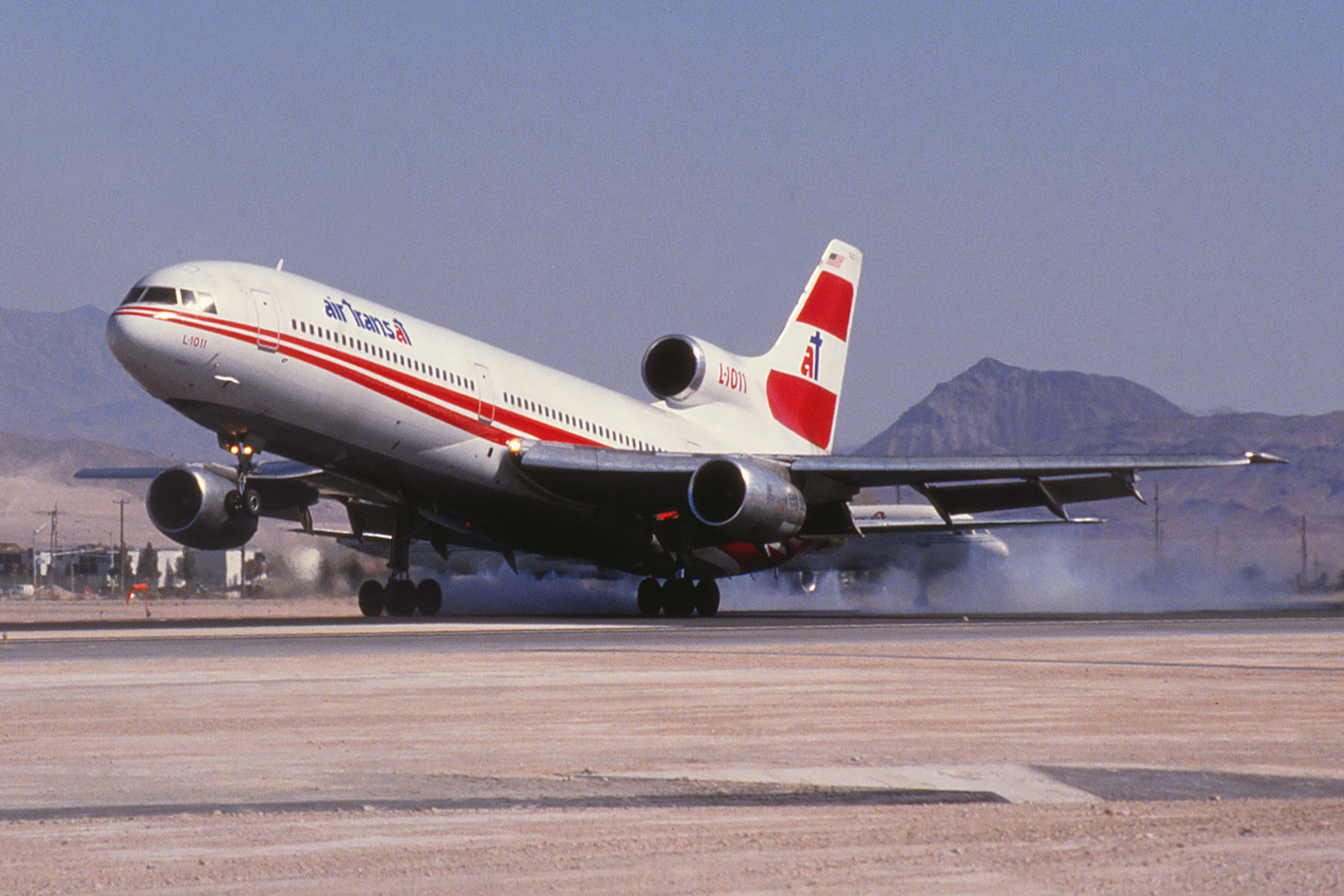
An Air Transat Lockheed L-1011 lands at Las Vegas International Airport (KLAS), February 1991, Matt Birch (http://visualapproachimages.com/)
When I was stationed in Hawaii with the Air Force, I often found myself flying with the airlines to somewhere in the Continental U.S. to pick up an airplane that had been broken or in extended maintenance. Most of our pilots hated these because you ended up having to do long preflight inspections to make sure the airplane was okay and, even worse, waiting for what had been repaired to really be repaired. I didn't have much choice at first because of seniority, but after a while I figured out this was a great way to learn so I tended to do a lot of these.
Back then it was next to impossible to get a direct flight from Hawaii to anywhere on the continent other than LAX or SFO, so we tended to fly to California and then hop on another airplane to where we were going. I once had the good fortune to be on an airplane going from HNL to LAX to ICT, all on one aircraft. I was seated in the cattle car class between a window and a talkative fellow who had been on a business trip to Hawaii and was on his way back to Wichita. I learned his life's story before we even leveled off. I told him I was an Air Force pilot but not much else. I brought a book and he took the hint.
The Los Angeles skies were docile for our descent and approach. I grimaced as I watched the fixed distance markers of the runway slide by. The airplane finally kissed the runway about halfway down the runway to the applause of most the passengers, included the one seated to my right. He concluded his clap with a thumbs up aimed my way, "Nice!"
After a few hours we boarded the same airplane and those of us continuing in our same seats. The winds were howling at Wichita and the pilot did a good job putting us down in the touchdown zone with a firm thud. My seat-mate gave a bit of a chuckle and laughed. "Not as good as the first pilot. I hope he catches hell for that!"
"Why do you say that," I asked.
"Didn't you notice?" he asked. "That was a lousy landing!"
"It's hard to judge from the cabin of the airplane," I said. "But it seemed okay to me."
He laughed some more. "Well maybe you weren't paying attention. But he clearly landed on one set of wheels before the other."
"Oh," I said. I didn't feel like going into the details of the wing-low crosswind landing technique.
Many years later, I was a passenger on a commercial airline flight into New York’s La Guardia Airport (LGA). I was sitting on the right side of the airplane, just forward of the wing for our approach, doing my best to appear the nonchalant passenger. “Yeah, I’m a pilot,” my look was designed to telegraph. “I’ve done this approach a hundred times and it is no big deal.”
Every now and then I would steal a glance out the window and deduced we were on a visual approach to Runway 31. Gear, flaps and engine pitch told me were established on glide path. When the throttles came to idle my eyes were shut, feigning the sleep of a weary traveler.
And then . . . nothing. As a pilot, I shoot for idle thrust at touchdown and don’t mind another pilot getting the throttles a little early. But I would never tolerate a 5 sec. flare. I opened my eyes just as the wheels kissed the pavement and I saw the single-bar fixed-distance marker disappear under our wing.
It wasn’t as bad as I had imagined, I thought. The single-bars are 2,500 ft. down the runway, so it was a long landing but not terrible. But then I saw the double-bar fixed distance marker. We hadn’t touched down just 2,500 ft. from the approach end of Runway 31 but with just over 2,500 ft. remaining from the departure end. The runway is 7,003 ft. long so our long landing was 4,500 ft. from the approach end.
Predictably, the pilot gave the aircraft all the brakes he could muster and I could feel the anti-skid system doing its best to keep the tires from turning into a pool of liquefied rubber. The airplane came to an unceremonious stop and we made a 90-deg. turn to the left, our wing tracing a line over the opposite runway’s edge and giving us on the right side of the aircraft a close-up view of Flushing Bay.
My thoughts ran back to three airliners that ended up in the water here, all due to pilot error. An Eastern Air Lines flight in 1945 failed to stop after an approach that was too high and too fast. A USAir flight crashed after the pilot was unable to keep the airplane on the runway during takeoff because his rudder trim was misset. In 1992, another USAir flight failed to take off because it was not properly deiced. And now, in 2014, we almost added another to the list.
As we passengers deplaned, the captain stood at the entry door, beaming a major airline smile, ready to accept the accolades for his “grease job” landing. I looked him in the eye and said, “I know where you touched down and I don’t appreciate it.” He diverted his eyes to his shoes and said, “I know, I’m sorry.”
Hypothesis: All Pilots Are Extremely Good Looking
Well okay. This one is true.

